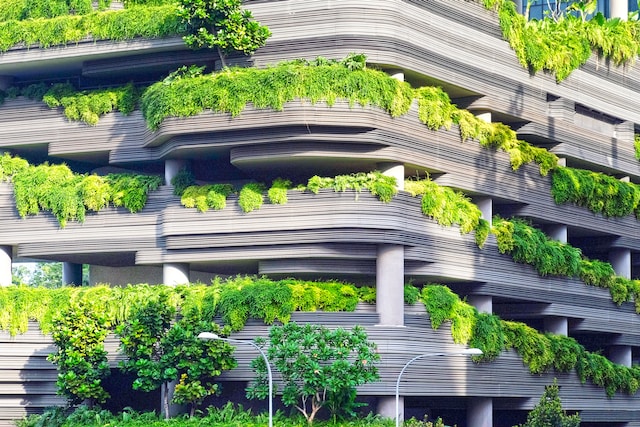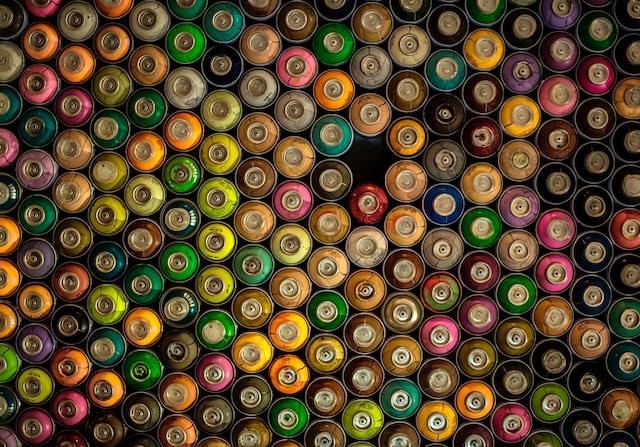In today’s rapidly changing world, finding sustainable solutions is becoming increasingly important. That’s why we’re excited to introduce “Over 50 Sustainable Materials Shaping A Better Future.” This innovative product is a comprehensive guide that showcases more than 50 sustainable materials that are shaping the way we live, work, and build for a better future. With a focus on sustainability, this guide provides valuable information and insights on a wide range of materials that can help individuals and businesses make more informed and environmentally conscious choices. Whether you’re an architect, designer, or simply someone interested in sustainable living, this guide is sure to inspire and educate you on the endless possibilities of a greener future.

1. Wood-Based Materials
Wood is a versatile and sustainable material that has been used for centuries in various applications. Today, there are several wood-based materials that are not only eco-friendly but also offer unique properties and benefits. Let’s explore some of these sustainable options:
1.1 Recycled Wood
Recycled wood, also known as reclaimed wood, is obtained by repurposing old wooden structures such as buildings and furniture. By salvaging and reusing this material, we can reduce the demand for newly harvested timber, which helps in conserving forests. Recycled wood can be used for flooring, furniture, decking, and even decorative items, adding a touch of vintage charm to any space.
1.2 Bamboo
Bamboo is a fast-growing plant that can be harvested sustainably within a few years, making it an excellent alternative to traditional hardwoods. It is incredibly strong and durable, making it suitable for construction and furniture. Moreover, bamboo produces more oxygen and absorbs more carbon dioxide compared to other trees, making it an environmentally friendly choice.
1.3 Cork
Cork is derived from the bark of the cork oak tree and is a renewable and biodegradable material. The extraction process does not harm the tree, as the bark regenerates over time. Cork is known for its excellent insulating properties, making it suitable for flooring and wall coverings. It is also commonly used for wine bottle stoppers and as an alternative to synthetic materials in various industries.
1.4 Reclaimed Timber
Similar to recycled wood, reclaimed timber involves repurposing old wood, particularly from demolished buildings and structures. Reclaimed timber possesses unique character and beauty, with each piece telling a story of its own. It can be used for flooring, furniture, cladding, and architectural elements, adding warmth and a sense of history to any project.
2. Plant-Based Materials
Plants offer a wide range of sustainable materials that can be used in various industries. From textiles to building materials, plant-based materials provide a renewable and environmentally friendly alternative. Let’s explore a few popular options:
2.1 Cotton
Cotton is one of the most widely used plant-based materials in the textile industry. It is a natural fiber that is breathable and soft, making it suitable for clothing. However, conventional cotton farming practices often involve heavy pesticide and water usage. To promote sustainability, organic and fair-trade cotton options are becoming increasingly popular.
2.2 Hemp
Hemp is a versatile plant that can be used to produce various materials, including textiles, paper, and even bioplastics. It requires minimal water and pesticide usage, making it a sustainable alternative to traditional crops. Hemp fibers are strong and durable, making them suitable for clothing, accessories, and even construction materials.
2.3 Soy
Soybeans are not only a valuable source of protein but also offer sustainable alternatives to traditional materials. Soy-based foam, for example, can be used as a substitute for petroleum-based foam in furniture and mattresses. Soy-based inks and solvents are also gaining popularity in the printing industry.
2.4 Linen
Linen is derived from the flax plant and is known for its durability and breathability. It requires less water and pesticides compared to cotton, making it a more sustainable option. Linen is commonly used in clothing, bedding, and home textiles, providing a natural and eco-friendly alternative.
3. Bio-based Plastics
Plastics have become an integral part of our daily lives, but their production and disposal pose significant environmental challenges. Bio-based plastics offer a sustainable alternative by utilizing renewable resources. Let’s explore some popular options:
3.1 Polylactic Acid (PLA)
Polylactic acid, or PLA, is a bio-based plastic derived from plant sugars, most commonly corn starch or sugarcane. It is biodegradable and compostable, making it a suitable alternative to traditional petroleum-based plastics. PLA is commonly used for packaging, disposable cutlery, and food containers.
3.2 Polyhydroxyalkanoates (PHA)
Polyhydroxyalkanoates, or PHA, are a type of bio-based plastic produced by microorganisms. They are fully biodegradable and can be composted in industrial facilities. PHA is versatile and can be used in various applications, including packaging, medical products, and even 3D printing.
3.3 Polyethylene Terephthalate (PET)
Polyethylene terephthalate, or PET, is a commonly used plastic in the beverage and packaging industry. While traditional PET is derived from fossil fuels, bio-based PET is produced using renewable resources such as sugarcane. It offers the same properties as conventional PET but with a lower carbon footprint.
3.4 Polybutylene Succinate (PBS)
Polybutylene succinate, or PBS, is a bio-based plastic derived from renewable resources such as corn and sugarcane. It is biodegradable and compostable, making it suitable for various applications, including packaging, disposable cutlery, and agricultural films.
4. Natural Fibers
Natural fibers offer a sustainable and biodegradable alternative to synthetic fibers. They are derived from various plant sources and have a wide range of applications. Let’s explore a few popular natural fibers:
4.1 Flax Fiber
Flax fiber, also known as linen, is derived from the flax plant. It is known for its strength, durability, and moisture-wicking properties. Flax fiber can be used in textiles, such as clothing and home furnishings, as well as in composite materials for automotive and construction industries.
4.2 Jute Fiber
Jute fiber is derived from the jute plant and is commonly used in packaging materials and textiles. It is a strong and durable fiber that is also biodegradable. Jute is often used in bags, rugs, and upholstery, offering a sustainable and eco-friendly alternative.
4.3 Coconut Fiber
Coconut fiber, also known as coir, is derived from the husk of coconut. It is a strong and durable fiber that is resistant to rot and mold. Coconut fiber is commonly used in the production of mats, ropes, and even as a plant growing medium in gardening.
4.4 Kenaf Fiber
Kenaf fiber is derived from the kenaf plant, which is a member of the hibiscus family. It is a fast-growing plant that produces long and sturdy fibers. Kenaf fiber can be used in various applications, including textiles, paper products, and even as a reinforcement material in composite structures.
5. Recycled Materials

Recycling plays a crucial role in minimizing waste and conserving resources. Many materials can be recycled and repurposed, reducing the need for new production. Let’s explore some popular recycled materials:
5.1 Recycled Paper
Recycled paper is made from post-consumer waste paper, reducing the demand for virgin wood pulp. It can be used in various applications, including printing and packaging. By choosing recycled paper products, you can contribute to reducing deforestation and landfill waste.
5.2 Recycled Glass
Recycled glass is made from crushed glass bottles and other glass waste. It can be melted and molded into new glass products without the need for significant energy consumption. Recycled glass can be used in the production of containers, countertops, and even decorative items, reducing the demand for new glass production.
5.3 Recycled Plastic
Recycled plastic is derived from post-consumer plastic waste, such as bottles and packaging materials. It can be processed and transformed into new plastic products, reducing the need for virgin plastic production. By opting for recycled plastic, you can help in reducing plastic pollution and conserving resources.
5.4 Recycled Metal
Recycled metal can be obtained from scrap metal and industrial waste. It can be melted and reshaped into new metal products without losing its properties. Recycling metal helps in reducing energy consumption and the need for mining raw materials. Recycled metal can be used in various industries, including construction and manufacturing.
6. Algal Materials
Algae, a diverse group of aquatic organisms, hold immense potential as a sustainable resource. They can be utilized to produce various materials with minimal environmental impact. Let’s explore a few algal materials:
6.1 Algal Biomass
Algal biomass refers to the collective mass of algae, which can be harvested and processed into different materials. It can be used as a renewable source for biofuels, animal feed, and even as a nutritional supplement for humans. Algal biomass offers a sustainable alternative to traditional fossil fuels and intensive agricultural practices.
6.2 Algal Bioplastics
Algal bioplastics are derived from algae and offer an eco-friendly alternative to petroleum-based plastics. They can be used in various applications, including packaging, disposable cutlery, and even 3D printing. Algal bioplastics are biodegradable and have a lower carbon footprint compared to traditional plastics.
6.3 Algal Biofuel
Algal biofuel is a renewable energy source derived from algae. Algae can be cultivated to produce oils that can be converted into biodiesel or other forms of biofuels. Algal biofuel offers several advantages, including high productivity, efficient land use, and reduced greenhouse gas emissions compared to conventional fossil fuels.
6.4 Algal Fertilizer
Algae-based fertilizers offer a sustainable and environmentally friendly alternative to traditional chemical fertilizers. They provide essential nutrients to plants while promoting soil health and microbial activity. Algal fertilizers improve crop yields and reduce the reliance on synthetic fertilizers, thus minimizing negative impacts on the environment.

7. Mycelium-Based Materials
Mycelium, the vegetative part of fungi, can be harnessed to create sustainable and versatile materials. It has gained attention in recent years for its ability to transform organic waste into valuable products. Let’s explore a few mycelium-based materials:
7.1 Mycelium Leather
Mycelium leather, also known as fungal leather, is a sustainable alternative to animal-based leather. It is created by growing mycelium on agricultural byproducts, such as sawdust and hemp fibers. The resulting material is biodegradable, cruelty-free, and can be used in various applications, including fashion, accessories, and upholstery.
7.2 Mycelium Packaging
Mycelium-based packaging, also known as mushroom packaging, is an eco-friendly alternative to traditional foam and plastic packaging materials. It is created by allowing mycelium to grow and bind together agricultural waste. Mycelium packaging is biodegradable, lightweight, and can be molded to fit various shapes, providing a sustainable solution for shipping and transportation.
7.3 Mycelium Building Materials
Mycelium can be used to create strong and durable building materials. It can be grown and shaped into blocks or panels, offering a sustainable alternative to traditional construction materials such as concrete and wood. Mycelium building materials are lightweight, fire-resistant, and have excellent insulation properties, making them ideal for sustainable architecture.
7.4 Mycelium Textiles
Mycelium can also be used to produce biodegradable textiles. By growing mycelium on agricultural waste or other natural fibers, it creates a flexible and durable material that can be used for clothing, accessories, and even home textiles. Mycelium textiles offer a sustainable alternative to synthetic fibers and contribute to the circular economy.
8. Natural Dyes
Natural dyes are derived from plant sources and offer an eco-friendly alternative to synthetic dyes. They are often obtained from leaves, flowers, roots, and bark of various plants. Let’s explore a few popular natural dyes:
8.1 Indigo
Indigo is a natural dye extracted from the leaves of the indigofera plant. It is one of the oldest and most widely used natural dyes, known for its deep blue color. Indigo dye has been used for centuries in textile dyeing and continues to be a sustainable choice for creating vibrant blue shades.
8.2 Turmeric
Turmeric, a vibrant yellow spice, can also be used as a natural dye. It produces a range of yellow hues and is commonly used in textile dyeing. Turmeric is a readily available and environmentally friendly option for adding warmth and brightness to fabrics.
8.3 Beetroot
Beetroot is not only a nutritious vegetable but can also be used as a natural dye. It produces a deep red or pink color and can be used in textile dyeing. Beetroot dye offers a sustainable and non-toxic alternative to synthetic red dyes.
8.4 Madder Root
Madder root, derived from the Rubia tinctorum plant, has been used as a dye for centuries. It produces a range of red and orange shades and is especially valued for its colorfastness. Madder root dye can be used in textile dyeing, providing a sustainable and long-lasting alternative.
9. Geopolymer Materials
Geopolymers are a type of inorganic material that can be used as a sustainable alternative to traditional cement and concrete. They are typically made by mixing natural minerals with a binder, such as sodium silicate. Let’s explore a few geopolymer materials:
9.1 Fly Ash Geopolymers
Fly ash geopolymers utilize fly ash, a byproduct of coal combustion, as a primary ingredient. By using fly ash instead of cement, these geopolymers contribute to reducing waste and minimizing carbon emissions. Fly ash geopolymers offer comparable strength to traditional concrete with improved durability and reduced environmental impact.
9.2 Rice Husk Geopolymers
Rice husk geopolymers utilize rice husk ash, a byproduct of rice milling, as a primary ingredient. Rice husk ash is rich in silica and can be used to create strong and lightweight materials. Rice husk geopolymers have excellent thermal insulation properties, making them suitable for construction applications.
9.3 Clay Geopolymers
Clay geopolymers utilize clay minerals as a primary ingredient. Clay is abundant and widely available, making it a sustainable choice for geopolymer production. Clay geopolymers offer high compressive strength and can be used in various applications, including construction and ceramics.
9.4 Slag Geopolymers
Slag geopolymers utilize blast furnace slag, a byproduct of iron and steel production, as a primary ingredient. By using slag instead of cement, these geopolymers help in reducing waste and the carbon footprint associated with traditional construction materials. Slag geopolymers offer improved mechanical properties and chemical resistance compared to conventional concrete.
10. Liquid Wood
Liquid wood, also known as lignin-based wood, is a biodegradable and renewable material that can be used as an alternative to petroleum-based plastics. It is derived from lignin, a natural polymer found in wood. Let’s explore a few liquid wood options:
10.1 Lignin-Based Liquid Wood
Lignin-based liquid wood can be processed and molded into various shapes and forms, similar to traditional plastics. It offers excellent mechanical properties, including high strength and impact resistance. Lignin-based liquid wood can be used in applications such as packaging, automotive components, and consumer goods.
10.2 Cellulosic Liquid Wood
Cellulosic liquid wood is derived from cellulose, another natural polymer found in plants. It can be processed into a liquid form and molded into various shapes. Cellulosic liquid wood offers biodegradability and can be used in applications such as packaging, utensils, and even 3D printing.
10.3 Nanocellulose Liquid Wood
Nanocellulose liquid wood utilizes nanocellulosic fibers, which are derived from cellulose and possess excellent mechanical properties. It can be processed into a liquid form and molded into various shapes and structures. Nanocellulose liquid wood offers biodegradability, high strength, and lightweight characteristics, making it suitable for applications such as packaging, construction, and electronics.
10.4 Lignocellulosic Liquid Wood
Lignocellulosic liquid wood combines lignin and cellulose, creating a versatile and sustainable material. It can be processed into a liquid form, enabling molding into various shapes and structures. Lignocellulosic liquid wood offers biodegradability and can be used in applications such as furniture, toys, and consumer goods.
In conclusion, the use of sustainable materials is crucial in shaping a better future for our planet. The wide range of wood-based, plant-based, bio-based plastics, natural fibers, recycled materials, algal materials, mycelium-based materials, natural dyes, geopolymers, and liquid wood provides sustainable alternatives to traditional materials. By incorporating these eco-friendly options into our daily lives and industries, we can contribute to a greener and more sustainable future for generations to come.









